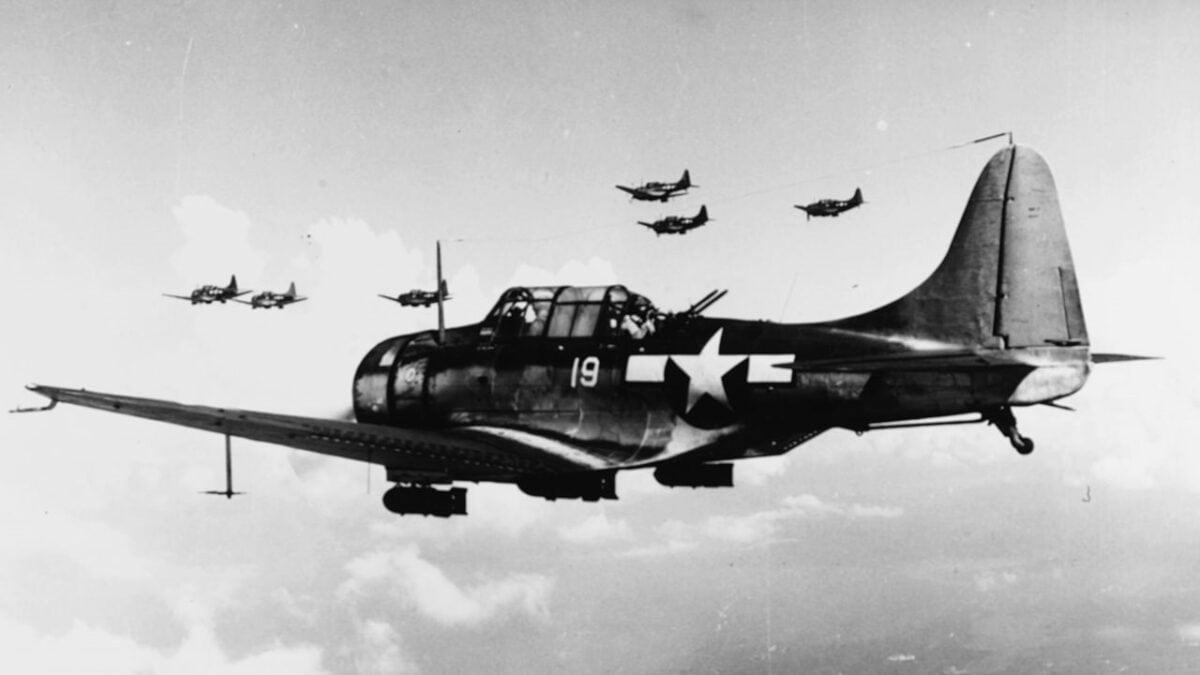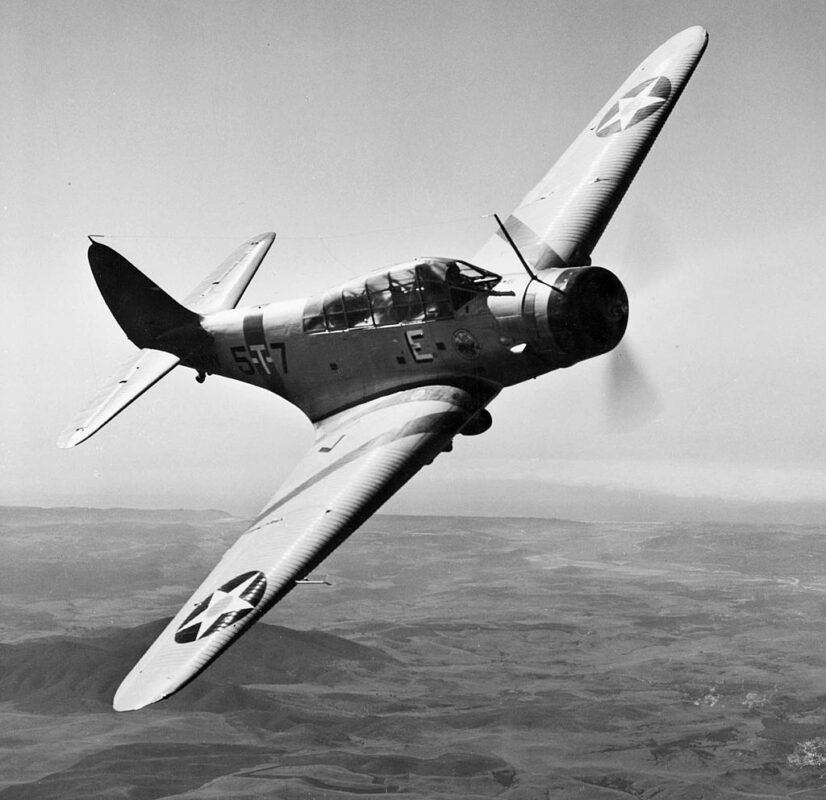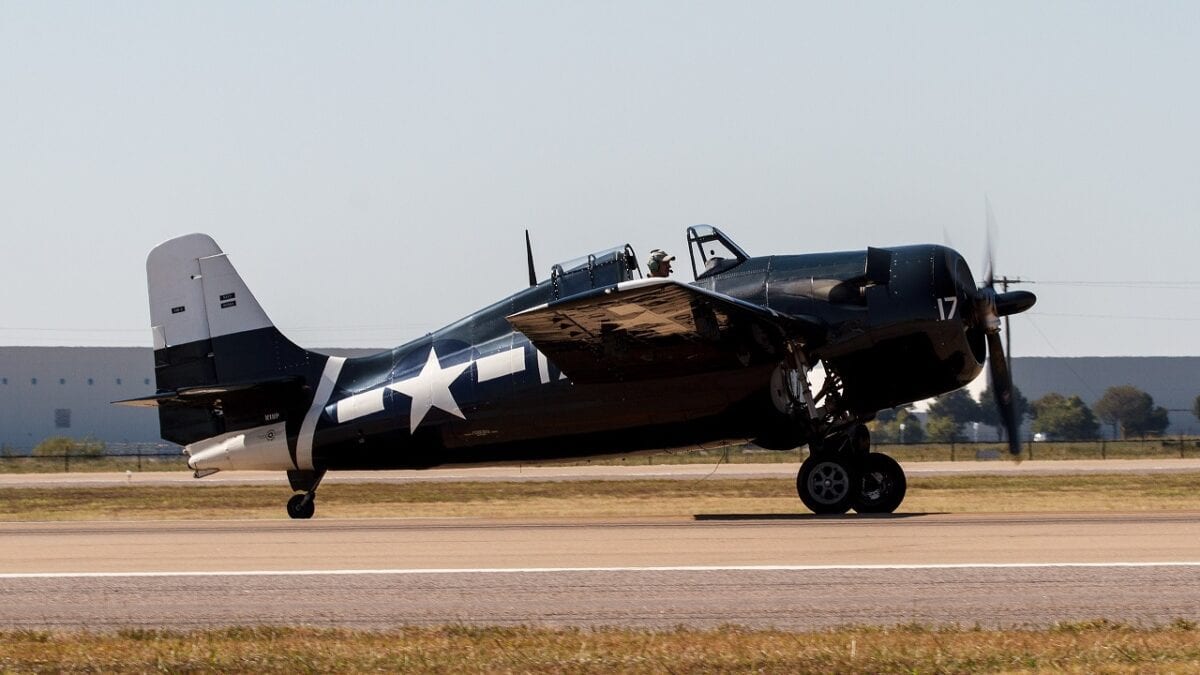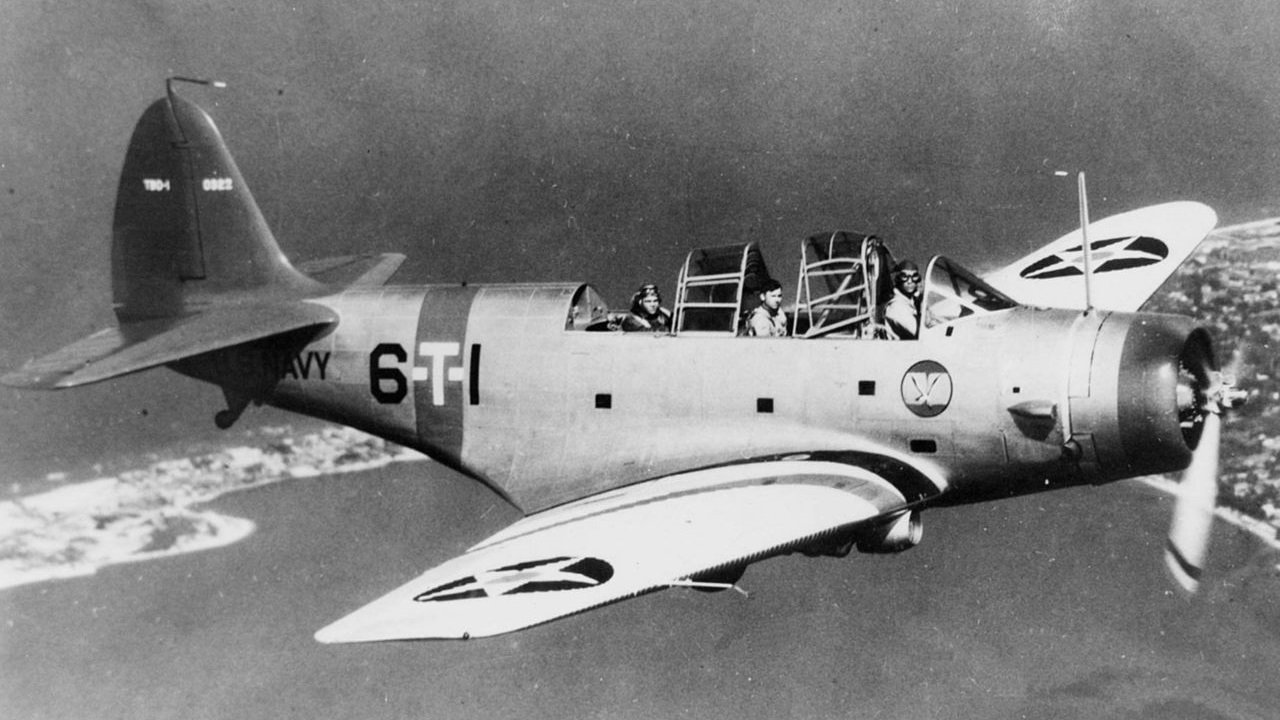Just recently, 19FortyFive began a multi-article series on the 80th anniversary of the Battle of Midway with a general overview of the battle and more coming over the next few days. Today we will focus on the American warplanes that made this smashing, epic victory possible.
“Slow But Deadly”: The Douglas SBD Dauntless
Yes, I know, there’s the philosophy of “Save the Best for Last,” but I’m going to be a contrarian here and start off with the “valedictorian” of the Midway warplane class (so to speak). The Douglas SBD Dauntless—specifically the SBD-3 version in this instance—without a doubt was the weapons system that did the lion’s share of the damage to the Imperial Japanese Navy (IJN) during the battle. SBD-dropped 1,000-pound bombs were solely responsible for the sinking of the four Japanese aircraft carriers—Akagi, Kaga, Sōryū, and Hiryū. as well as the sinking of the heavy cruiser Mikuma and severely damaging the heavy cruiser Mogami.
Adding to the SBD’s impressive wartime laurels are the fact that it could also claim the lowest loss ratio of any U.S. Navy carrier-based combat aircraft in World War II. Even more impressive is that the Dauntless stands out as the only WWII bomber with a positive kill ratio against enemy fighters, with 138 officially credited air-to-air victories vs. 43 losses of their own. Mind you, this wasn’t just accomplished by the SBD’s rear gunners with their swivel-mounted .30 caliber machine guns, but also by the pilots themselves who made good use of the plane’s forward-firing, cowling-mounted Browning .50 caliber machine guns. Among the Dauntless pilots who managed to kill the vaunted Japanese Zero was the legendary Stanley “Swede” Vejtasa, who pulled off this highly improbable feat as a young Lieutenant (j.g.) during the Battle of the Coral Sea.

U.S. Navy Douglas SBD-5 Dauntless dive bombers of Bombing Squadron 16 (VB-16), Carrier Air Group 16, from the aircraft carrier USS Lexington (CV-16), fly over the invasion fleet off Saipan, on “D-Day”, 15 June 1944.
The Douglas TBD Devastator: A Noble Sacrifice
If the Dauntless was the “lion” of U.S. combat aircraft over Midway, then the Devastator was the unfortunate “sacrificial lamb.” When it debuted in 1937, the Devastator—ironically manufactured by the same company that produced the oh-so-successful Dauntless—was the most sophisticated aircraft in the world, and it did have its “one brief shining moment” (so to speak) during the Battle of the Coral Sea, when it helped sink the IJN light carrier Shōhō.
Alas, during the Battle of Midway, the slow, lumbering Devastator was easy pickings for Japanese fighters and shipborne triple-A guns alike. The TBD crews scored nary a single hit on any IJN vessels, whilst losing 35 out of 41 of their number, including the USS Hornet’s entire contingent! Then-Ensign George Gay was the sole survivor of the Hornet’s Devastator crews.

TBD-1 Devastator. Image Credit: Creative Commons.
The Devastator crews’ sacrifice was not in vain, however. As Peter Suciu explains in The National Interest: “However, the TBSs [sic] – without really intending to do so – kept the shipboard guns and more importantly the defending Japanese aircraft occupied at low altitude. The American aircraft also managed to strafe the Japanese fleet, which caused the carriers to take sharp evasive maneuvers, which limited the Japanese ability to quickly recover and refuel their fighters. That gave a huge opportunity to the American dive bombers, which arrived undetected to zoom down from high altitudes and dropped bombs on the carrier flight decks.”
The Brewster F2A3 Buffalo: Another Noble Sacrifice
The stubby, ungainly-looking Brewster Buffalo has been dubbed by some wags as the worst fighter plane of WWII. Actually, that’s not entirely fair to the Buffalo, as Finnish Air Force Buffalo pilots actually used the fighter to devastating effect against the Soviet Air Force during the so-called Continuation War of 1941-1944, as 36 of Finland’s 96 top fighter pilots became aces in Brewsters, including six of the top 10.

Brewster F2A3 Buffalo.
But against the faster, more nimble Zero with its 20mm cannons, the Brewster F2A3 was simply outclassed. If you’ll forgive a bad culinary pun here, the Zero pilots ground the Buffalo wings into Buffalo burgers. Out of the 20 USMC-flown Buffalos that responded to the Japanese bombing raid on the Midway Island installations, 13 were shot down. Repeated gun-jamming issues certainly didn’t help their cause. On a positive note, the Buffalo drivers still did manage to kill at least one Zero as well as two Aichi D3A1 “Val” dive bombers. Moreover, the Midway base facilities suffered relatively little damage, which goes to show that just as with the star-crossed TBD Devastator, the Brewster Buffalo’s sacrifice was not in vain.
The Grumman F4F Wildcat: Not Quite the F6F Hellcat, But Still Pretty Darn Good
The F4F would prove itself far more successful that the F2A3 during the Battle of Midway and WWII as a whole. Though it wasn’t until the advent of the F6F Hellcat and Vought F4U Corsair that the U.S. Navy and Marine Corps gained true air superiority against the Zero, the older Wildcat more than held its own in the meantime. Though not as fast or maneuverable as its IJN adversary, the Wildcat had the advantage of greater survivability due to its combination of armor and self-sealing fuel tanks, whilst its four wing-mounted Browning .50 caliber machine guns could light up the unarmored Japanese planes like tinderboxes. It was during the Battle of Midway that the F4F’s pilots first tested the now-famous “Thach Weave” maneuver to give themselves a better fighting chance against the Zeros. The Thach Weave would enable Wildcat drivers to claim an air combat kill-to-loss ratio of 5.9:1 in 1942.

Grumman F4F Wildcat. Image Credit: Creative Commons.
Next Up
Now that we’ve talked about the warbirds, 19FortyFive will conclude its series on the Battle of Midway’s 80th anniversary with a look at the comparatively unsung aspect of the battle: the submarine USS Nautilus’s inadvertent contribution to the crushing defeat of the IJN.
Christian D. Orr is a former Air Force officer, Federal law enforcement officer, and private military contractor (with assignments worked in Iraq, the United Arab Emirates, Kosovo, Japan, Germany, and the Pentagon). Chris holds a B.A. in International Relations from the University of Southern California (USC) and an M.A. in Intelligence Studies (concentration in Terrorism Studies) from American Military University (AMU). He has also been published in The Daily Torch and The Journal of Intelligence and Cyber Security. Last but not least, Mr. Orr is a Companion of the Order of the Naval Order of the United States (NOUS).

